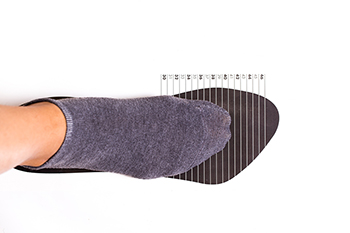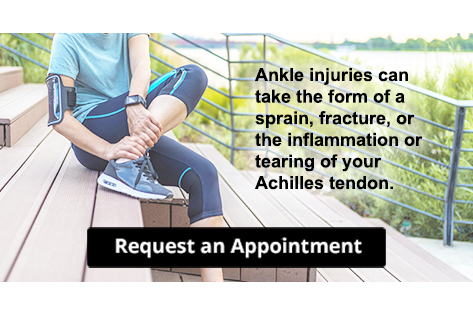Blog
Items filtered by date: July 2023
How the Feet Can Be Measured

People who stand or walk for the majority of the day are generally aware of what type of shoes they wear and how well they fit. Many patients will try on multiple pairs of shoes before they find a pair that fits their feet perfectly. It is beneficial to have an accurate foot measurement before purchasing shoes. This can be done by tracing the width and length of the foot on a piece of paper, followed by using a conversion table that can pinpoint the right size. Many stores are equipped with a Brannock device, which can accurately measure the foot. Additionally, it can help to wear the socks that will be worn with the new shoes, and these can range from dress socks to athletic socks. The best time of day to purchase shoes is in the evening when the feet are at their largest. This often ensures a proper fit when the feet become swollen after a long day. If you would like more information about how to determine your right shoe size, it is suggested that you confer with a podiatrist who can provide you with the appropriate knowledge.
Finding a properly-fitting shoe is important in reducing injuries and preventing foot problems. For more information about treatment, contact David Lambarski, DPM from Northeast Foot Care. Our doctor will treat your foot and ankle needs.
Proper Shoe Fitting
A common concern when it comes to foot health, having properly fitted shoes can help prevent injuries to the foot. Out feet affect our posture and gait, which in turn affects the biomechanics and overall bodily structure. With 33 joints, 26 bones, and over 100 ligaments, the potential for serious injury is much greater than one realizes. Although the feet cease growth in adulthood, they still change shape as they mature. Here are some factors to consider when it comes to investing in proper fitting shoes:
- Be sure the shoes fit correctly right away
- Ensure the ball of your foot fits comfortably in the widest portion of the shoes
- Even though they may look fashionable, improper fitting shoes can either create adverse conditions or exacerbate existing ones you may already have
- Walk along a carpeted surface to ensure the shoes comfortably fit during normal activity
Keeping in mind how shoes fit the biomechanics of your body, properly-fitting shoes are vitally important. Fortunately, it is not difficult to acquire footwear that fits correctly. Be sure to wear shoes that support the overall structure of your body. Do your feet a favor and invest in several pairs of well-fitted shoes today.
If you have any questions please feel free to contact our offices located in Amsterdam and Clifton Park, NY . We offer the newest diagnostic and treatment technologies for all your foot and ankle needs.
Dealing With Athlete’s Foot

Athlete’s foot, which is a fungal infection termed tinea pedis, often causes an eruption of blisters between the toes or on the bottom of the foot. The blisters are filled with a clear liquid, which in and of itself is not problematic. Other symptoms can include scaling skin, redness, and itchiness. It is important to know that the fungus that causes athlete’s foot is extremely contagious and can easily spread to other body parts. Be sure to wash your hands after touching the infected area. Men, people who are diabetic, and anyone with eczema may be more likely to become infected with athlete’s foot. The best way to prevent coming into contact with the fungus that causes athlete’s foot is to wear foot coverings in warm and moist public areas. This includes shower rooms and locker areas at gyms and swimming pools. If an athlete's foot infection does not react to common treatments, it is suggested that you make an appointment with a podiatrist who can examine the affected foot, and test the infected area to provide appropriate treatment measures.
Athlete’s foot is an inconvenient condition that can be easily reduced with the proper treatment. If you have any concerns about your feet and ankles, contact David Lambarski, DPM from Northeast Foot Care. Our doctor will treat your foot and ankle needs.
Athlete’s Foot: The Sole Story
Athlete's foot, also known as tinea pedis, can be an extremely contagious foot infection. It is commonly contracted in public changing areas and bathrooms, dormitory style living quarters, around locker rooms and public swimming pools, or anywhere your feet often come into contact with other people.
Solutions to Combat Athlete’s Foot
- Hydrate your feet by using lotion
- Exfoliate
- Buff off nails
- Use of anti-fungal products
- Examine your feet and visit your doctor if any suspicious blisters or cuts develop
Athlete’s foot can cause many irritating symptoms such as dry and flaking skin, itching, and redness. Some more severe symptoms can include bleeding and cracked skin, intense itching and burning, and even pain when walking. In the worst cases, Athlete’s foot can cause blistering as well. Speak to your podiatrist for a better understanding of the different causes of Athlete’s foot, as well as help in determining which treatment options are best for you.
If you have any questions please feel free to contact our offices located in Amsterdam and Clifton Park, NY . We offer the newest diagnostic and treatment technologies for all your foot and ankle needs.
Get Proper Treatment for Ankle Injuries
The Prevalence of Broken Toes

We may have all stubbed our toes into a piece of furniture or dropped something heavy on our toes and experienced intense pain. A fractured toe, particularly a pinky toe, is a common occurrence, especially because they involve small bones on the edge of the foot and are more prone to injury. When one breaks a toe, it is painful, and the toe will look bruised and swollen. If the ends of the broken bone get displaced, the toe may look crooked. It may be painful to walk with a broken toe, particularly if one breaks their big toe because this toe takes more weight when walking. Most broken toes can be treated at home. The buddy taping method is frequently used, which involves taping the broken toe to the toe next to it for stability. Wearing comfortable, enclosed, and sturdy shoes that do not press against the broken toe should also help. The only way to be certain a toe is broken versus being sprained or strained, is to have an X-ray taken. If a broken toe is associated with another injury or problem, if the big toe is the affected toe, if the skin is broken, or the toe is displaced it is strongly suggested that you see a podiatrist for proper evaluation and treatment.
Broken toes may cause a lot of pain and should be treated as soon as possible. If you have any concerns about your feet, contact David Lambarski, DPM from Northeast Foot Care. Our doctor will treat your foot and ankle needs.
What Is a Broken Toe?
A broken toe occurs when one or more of the toe bones of the foot are broken after an injury. Injuries such as stubbing your toe or dropping a heavy object on it may cause a toe fracture.
Symptoms of a Broken Toe
- Swelling
- Pain (with/without wearing shoes)
- Stiffness
- Nail Injury
Although the injured toe should be monitored daily, it is especially important to have a podiatrist look at your toe if you have severe symptoms. Some of these symptoms include worsening or new pain that is not relieved with medication, sores, redness, or open wounds near the toe.
If you have any questions, please feel free to contact our offices located in Amsterdam and Clifton Park, NY . We offer the newest diagnostic and treatment technologies for all your foot care needs.
Treating a Wound on the Bottom of the Foot

Having a wound on the bottom of the foot can not only be painful, but it can also be extremely difficult to treat. With any wound, cleaning and disinfecting it is important. Fortunately, minor cuts heal relatively quickly on their own, and an antibiotic ointment and simple bandage are enough to do the job. Staying off the foot as much as possible is a big help, too. The real problem with a wound on the bottom of the foot is when it is deep, won’t stop bleeding, or becomes infected. In those cases, it is suggested that you contact a podiatrist for immediate assistance. Keeping the wounded area covered is an effective and important way to avoid dire complications. After cleaning and dressing the area, adding a bandage, then a gauze wrapping, followed by an elastic bandage is suggested by experts. These bandages should be tight enough to protect the wound, but not so tight that circulation to the foot is cut off. If you are unsure of how to deal with a wound on the sole of the foot, it is suggested that you contact a podiatrist.
Wound care is an important part in dealing with diabetes. If you have diabetes and a foot wound or would like more information about wound care for diabetics, consult with David Lambarski, DPM from Northeast Foot Care. Our doctor will assess your condition and provide you with quality foot and ankle treatment.
What Is Wound Care?
Wound care is the practice of taking proper care of a wound. This can range from the smallest to the largest of wounds. While everyone can benefit from proper wound care, it is much more important for diabetics. Diabetics often suffer from poor blood circulation which causes wounds to heal much slower than they would in a non-diabetic.
What Is the Importance of Wound Care?
While it may not seem apparent with small ulcers on the foot, for diabetics, any size ulcer can become infected. Diabetics often also suffer from neuropathy, or nerve loss. This means they might not even feel when they have an ulcer on their foot. If the wound becomes severely infected, amputation may be necessary. Therefore, it is of the upmost importance to properly care for any and all foot wounds.
How to Care for Wounds
The best way to care for foot wounds is to prevent them. For diabetics, this means daily inspections of the feet for any signs of abnormalities or ulcers. It is also recommended to see a podiatrist several times a year for a foot inspection. If you do have an ulcer, run the wound under water to clear dirt from the wound; then apply antibiotic ointment to the wound and cover with a bandage. Bandages should be changed daily and keeping pressure off the wound is smart. It is advised to see a podiatrist, who can keep an eye on it.
If you have any questions, please feel free to contact our offices located in Amsterdam and Clifton Park, NY . We offer the newest diagnostic and treatment technologies for all your foot care needs.

